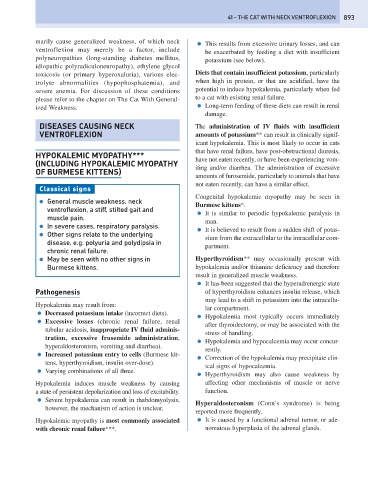Page 901 - Problem-Based Feline Medicine
P. 901
41 – THE CAT WITH NECK VENTROFLEXION 893
marily cause generalized weakness, of which neck ● This results from excessive urinary losses, and can
ventroflexion may merely be a factor, include be exacerbated by feeding a diet with insufficient
polyneuropathies (long-standing diabetes mellitus, potassium (see below).
idiopathic polyradiculoneuropathy), ethylene glycol
toxicosis (or primary hyperoxaluria), various elec- Diets that contain insufficient potassium, particularly
trolyte abnormalities (hypophosphatemia), and when high in protein, or that are acidified, have the
severe anemia. For discussion of these conditions potential to induce hypokalemia, particularly when fed
please refer to the chapter on The Cat With General- to a cat with existing renal failure.
ized Weakness. ● Long-term feeding of these diets can result in renal
damage.
DISEASES CAUSING NECK The administration of IV fluids with insufficient
VENTROFLEXION amounts of potassium** can result in clinically signif-
icant hypokalemia. This is most likely to occur in cats
that have renal failure, have post-obstructional diuresis,
HYPOKALEMIC MYOPATHY*** have not eaten recently, or have been experiencing vom-
(INCLUDING HYPOKALEMIC MYOPATHY iting and/or diarrhea. The administration of excessive
OF BURMESE KITTENS)
amounts of furosemide, particularly to animals that have
not eaten recently, can have a similar effect.
Classical signs
Congenital hypokalemic myopathy may be seen in
● General muscle weakness, neck
Burmese kittens*.
ventroflexion, a stiff, stilted gait and ● It is similar to periodic hypokalemic paralysis in
muscle pain. man.
● In severe cases, respiratory paralysis.
● It is believed to result from a sudden shift of potas-
● Other signs relate to the underlying
sium from the extracellular to the intracellular com-
disease, e.g. polyuria and polydipsia in partment.
chronic renal failure.
● May be seen with no other signs in Hyperthyroidism** may occasionally present with
Burmese kittens. hypokalemia and/or thiamine deficiency and therefore
result in generalized muscle weakness.
● It has been suggested that the hyperadrenergic state
Pathogenesis of hyperthyroidism enhances insulin release, which
may lead to a shift in potassium into the intracellu-
Hypokalemia may result from:
lar compartment.
● Decreased potassium intake (incorrect diets).
● Hypokalemia most typically occurs immediately
● Excessive losses (chronic renal failure, renal
after thyroidectomy, or may be associated with the
tubular acidosis, inappropriate IV fluid adminis-
stress of handling.
tration, excessive frusemide administration,
● Hypokalemia and hypocalcemia may occur concur-
hyperaldosteronism, vomiting and diarrhea).
rently.
● Increased potassium entry to cells (Burmese kit-
● Correction of the hypokalemia may precipitate clin-
tens, hyperthyroidism, insulin over-dose).
ical signs of hypocalcemia.
● Varying combinations of all three.
● Hyperthyroidism may also cause weakness by
Hypokalemia induces muscle weakness by causing affecting other mechanisms of muscle or nerve
a state of persistent depolarization and loss of excitability. function.
● Severe hypokalemia can result in rhabdomyolysis,
Hyperaldosteronism (Conn’s syndrome) is being
however, the mechanism of action is unclear.
reported more frequently.
Hypokalemic myopathy is most commonly associated ● It is caused by a functional adrenal tumor, or ade-
with chronic renal failure***. nomatous hyperplasia of the adrenal glands.

